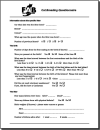A questionnaire-based study of gestation, parturition and neonatal mortality in pedigree breeding cats in the UK
- PMID: 16442825
- PMCID: PMC10832861
- DOI: 10.1016/j.jfms.2005.10.003
A questionnaire-based study of gestation, parturition and neonatal mortality in pedigree breeding cats in the UK
Abstract
This study was based on a convenience-sampling questionnaire study of pedigree cat breeding in the UK. Data were collated for the births of 1,056 litters from 14 different pedigree breeds and 942 different households. Significant relationships between various outcomes and relevant predictors were assessed by multiple linear regression or logistic regression as appropriate. The overall mean gestation length of 65.1 days varied significantly between the breeds (P<0.0001), and larger litter sizes were associated with shorter gestation lengths (P=0.04). The mean litter size of 4.6 kittens also varied significantly according to breed (P<0.0001). The weight of kittens born alive (overall mean 93.5 g) increased with longer gestation lengths (P=0.0003), decreased with larger litter sizes (P<0.0001) and varied between the breeds (P<0.0001). A total of 8.0% of pregnancies resulted in a caesarean section, with a higher risk associated with smaller litter sizes (P=0.002). Although the frequency of caesarean sections varied from 0 to 18.5% between individual breeds, breed itself was not shown to have a significant independent effect on this likelihood. A mean of 7.2% of all the kittens were stillborn, which varied according to breed (P=0.0003), and the risk of a stillborn kitten increased with litter size (P=0.0001), and with the presence of congenital defects in the litter (P=0.0002). The mean kitten mortality between birth and 8 weeks of age was 9.1%, and the majority of these occurred in the first week of life. Parturition intervals varied widely. The duration of first stage of labour was less than 2h in 82.9% of cats. The interval between the birth of the first and last kitten was less than 6h in 85.7%, but more than 48 h in three cats. A maximum of 48 h was recorded between the births of individual kittens in unassisted deliveries.
Figures










References
-
- Cave T.A., Thompson H., Reid S.W., Hodgson D.R., Addie D.D. Kitten mortality in the United Kingdom: a retrospective analysis of 274 histopathological examinations (1986 to 2000), Veterinary Record 151, 2002, 497–501. - PubMed
-
- Darvelid A.W., Linde-Forsberg C. Dystocia in the bitch: a retrospective study of 182 cases, Journal of Small Animal Practice 35, 1994, 402–407.
-
- Ekstrand C., Linde-Forsberg C. Dystocia in the cat: a retrospective study of 155 cases, Journal of Small Animal Practice 35, 1994, 459–464.
-
- Gerrits P.O., Huisman T., Knol B.W. Characteristics of pedigree cat breeding in the Netherlands: breeds, population increase and litter size, Tijdschrift voor diergeneeskunde 124, 1999, 145–148. - PubMed
-
- Gruffydd-Jones T.J. The genital system and paediatrics. Chandler E.A., Gaskell C.J., Gaskell R.M. Feline Medicine and Therapeutics, 2nd edn, 1994, Blackwell Science: Oxford, 269–286.
Publication types
MeSH terms
LinkOut - more resources
Full Text Sources
Miscellaneous

